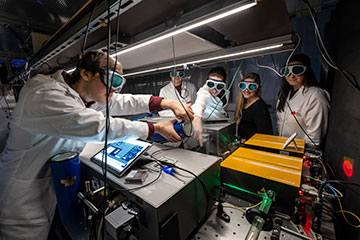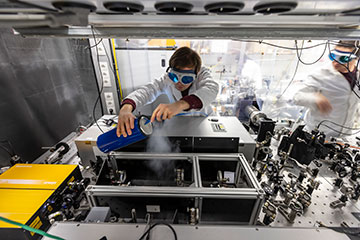
Birgitta Schultze-Bernhardt (second from right) and her team at their broadband UV dual-comb spectrometer. [Image: Lunghammer-Nawi Graz]
Anyone who felt the rapid change in humidity when this month’s solar eclipse reached totality had a physical experience of the drastic effect that the sun can have on Earth’s atmosphere. But UV rays have other impacts that are more difficult to observe, such as the creation of ground-level ozone when sunlight reacts with nitrogen oxides and many other photochemical reactions.
This is where spectroscopy comes in. Researchers in Austria have reportedly harnessed the high reaction potential of UV light, which is strongly absorbed by all materials, to develop the first broadband UV dual-comb spectrometer (Optica, doi: 10.1364/OPTICA.516783). They say that their new environmental-monitoring method can continuously measure air pollutants in real time.
Improving dual-comb spectrometers
Dual-comb spectrometers use a source that emits light in a broad wavelength range, which resemble the teeth of a comb when arranged according to its optical frequences. If that light meets a gas, some of it is absorbed by the sample’s molecules, altering the wavelengths and thereby providing information about the components and properties of the gas.
Birgitta Schultze-Bernhardt and colleagues from Graz University of Technology put a new spin on this method by introducing a laser system that emits double light pulses in the UV spectrum. When these pulses hit gas molecules, they cause rovibronic transitions―exciting the molecules electronically and causing them to rotate and vibrate―which are unique to each gas, acting as an identifiable signature.
The team’s spectrometer also offers three improvements over conventional spectometers that, “[make] our spectrometer suitable for sensitive measurements by which changes in gas concentrations and the course of chemical reactions can be observed very precisely,” explained first author Lukas Fürst.

Lukas Fürst leaning over the broadband UV dual-comb spectrometer that combines a wide bandwidth of emitted UV light, high spectral resolution and short measurement times. [Image: Lunghammer-Nawi Graz]
First, their device only needs a single measurement to gather large amounts of data on the optical properties of a gas because it emits a larger bandwidth of UV light than traditional spectrometers. It also has a high spectral resolution, which will allow complex mixtures of gases, like those found in Earth’s atmosphere, to be analyzed. Finally, their spectrometer needs less time than its predecessors for taking measurements.
Development and testing
Schultze-Bernhardt and her fellow researchers used formaldehyde as a sample material during development and testing of their device. Formaldehyde is a pollutant formed outdoors from burning fossil fuels and wood and indoors from the adhesive vapors in furniture. Using the new spectrometer, they were able to collect the rotational state-resolved absorption spectra of formaldehyde in only 100 microseconds―past studies took minutes to hours―using two broadband UV frequency combs centered at 871 THz and including a spectral bandwidth of 35.7 THz.
Schultze-Bernhardt explains, “With our new spectrometer, formaldehyde emissions in the textile or wood-processing industries as well as in cities with increased smog levels can be monitored in real time, thus improving the protection of personnel and the environment.”
The UV dual-comb spectrometer can also be applied more broadly to other gases, such as nitrogen oxides and ozone, because all molecular types strongly absorb in the UV spectrum. The team therefore hopes to use their method to gather new data on how these chemicals react in our atmosphere with the goal of gaining insight on how to improve air quality.
